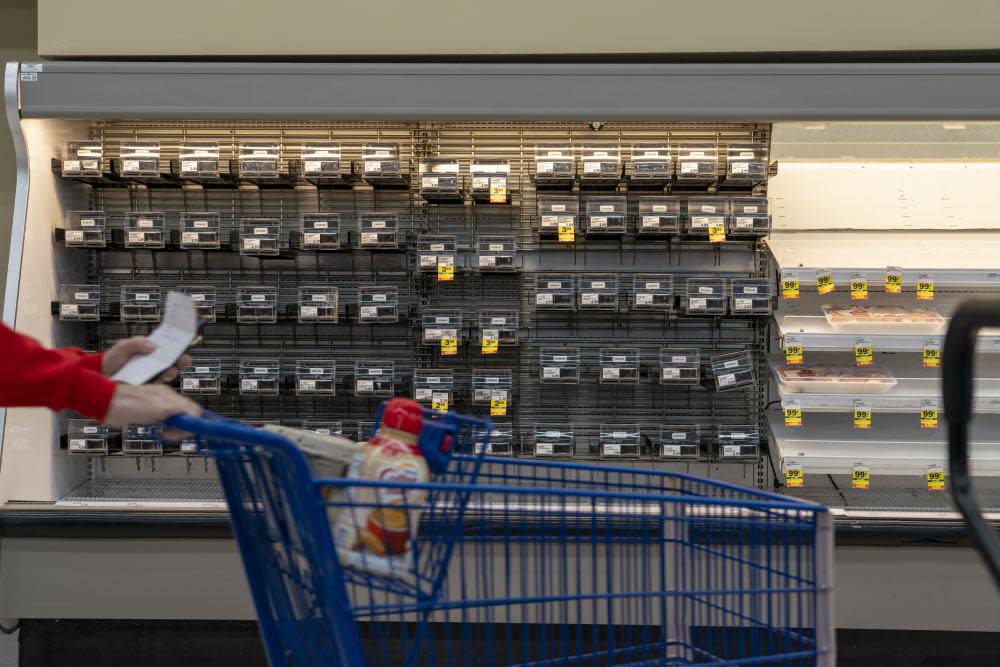‘Could you buy a little less, please?’: panic-buying disrupts food distribution

As coronavirus spreads in the US, many people are stockpiling essentials for what they believe will be periods of home confinement and panicked shoppers have stripped many US grocery stores of staples ranging from bread and milk to meat and toilet paper.
But, in fact, the virus currently poses little threat to the integrity of the US food supply. It is panic-buying itself that is causing the real disruption.
Experts interviewed by the Guardian said that while the grocery supply chain is generally fine at this point, rapid, dramatic shifts in consumer behavior have temporarily disrupted the market.
Related: Is it safe – and ethical – to order food online during the coronavirus outbreak?
Trump himself has sought to assuage fears by urging the country not to hoard groceries amid the outbreak, saying he had a call with grocery industry leaders who urged him to speak out against hoarding.
“They have actually asked me to say: ‘Could you buy a little bit less, please?’ I thought I’d never hear that from a retailer,” Trump remarked, also saying: “They have no shortages. We have no shortages other than people buying anywhere from three to five times [more].”
People don’t appear to have listened. There are still many spaces on supermarket shelves where bathroom tissue and milk should be.
So what, exactly, is going on?
Annelies Goger, a fellow with the Brookings Institution specializing in workforce and safety net programs, said that a widespread shift to work-from-home mandates played a role. Because people were working outside the home, they dined at more restaurants. Some companies provided meals to their employees. More than 50% of food expenditures were consumed away from home, Goger noted.
“Now, all those people are working from home and most of them are making food, and buying it at a grocery store, instead of going out,” Goger said. “Overnight, the channels whereby people are getting food are just completely changing.”
Daniel Stanton, who wrote Supply Chain Management for Dummies, said that recently hard-to-come-by staples are still around. The present distribution model isn’t aligned with the new buying behavior. People are buying more staples, but they’re not actually using more – what he described as “phantom demand”.
“The manufacturers are probably working overtime, three shifts, to produce toilet paper,” he said. “In a couple of weeks, all that toilet paper is going to end up at the stores, and nobody is going to have to buy toilet paper, because everybody’s stocked up.
“Really, I can assure you, the supply chains, they’re working fine,” he said. “The problem is, there are these delays. Over the course of the next couple of weeks, the aisles are going to be clogged with toilet paper.”
Stanton did say that the supply chain needed to shift to meet real demands of other items – that is, demands for products that people will actually use – such as medical masks and soaps.
He also thought that the social distancing inherent in two key parts of the food supply chain, agriculture and distribution, mitigates many workers’ coronavirus risk. However, he said, “There are infrastructure pieces that we need to have in place to help those industries continue.”
Stanton pointed to Pennsylvania transportation officials’ closure of rest stops along the highway – which truckers rely on for breaks, naps and restroom access. Following outcry, authorities there reportedly reopened 17 of 46 such stops.
“We absolutely need to be looking at what are the sectors, what are the infrastructures, that we need to protect and maintain, so that trucks, especially, can continue moving,” he said, noting “It’s also true for rail freight.”
Similarly, shutting down port terminals because of a positive coronavirus test, as happened in Houston, Texas, has risks. Shutting down migration across the US-Mexico border could deal a huge blow to agricultural production, he said.
“I don’t think we’re running out of food,” said Hannah Kain, president and CEO of supply chain firm Alom. “People want to be safe, and they do more storage at home, so we have all these filled freezers, etc.
“That being said, there’s a lot of, it’s getting harder to move things around and move over borders,” Kain said.
Most air cargo, she said, is transported in passenger planes. Because commercial airlines cut flights, cargo prices have gone up.
Maybe, under the most dire circumstances, “we could be in a world where transportation and production of food could be more restrained”, but that is a big step away from the food uncertainty one sees in the developing world, she said.
So, while shoppers might not see as many plums shipped from Chile, there will still be produce to eat.
“I think you can still get celery in most places, or carrots,” she said. “We have been very privileged the past 10, 15 years in being able to transport food from wherever it was at the peak, to where it was not so much at the peak.”

